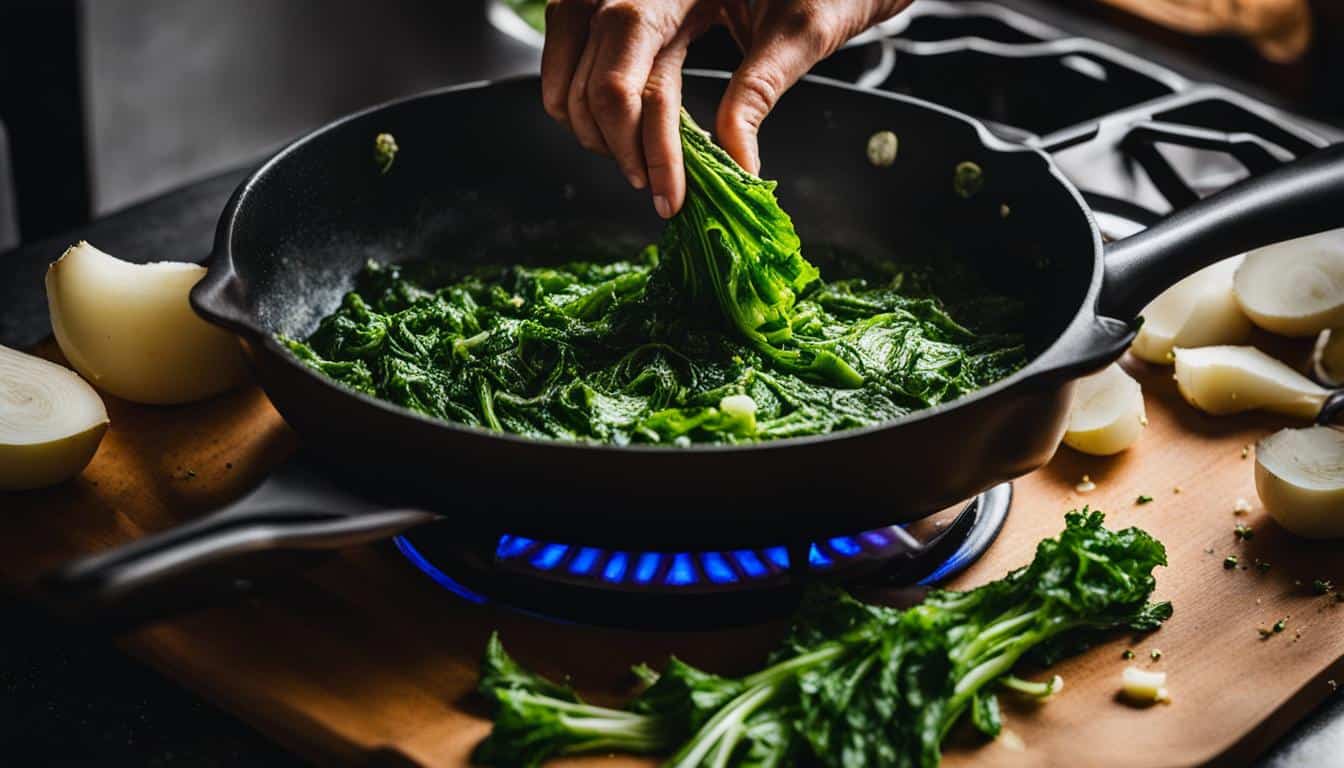Did you know that turnip greens are not only delicious but also incredibly nutritious? These leafy greens, often overlooked in favor of their popular root, pack a powerful punch when it comes to health benefits. From their high vitamin content to their potential role in preventing chronic diseases, turnip greens are a versatile and wholesome addition to any meal. In this article, I will guide you through the nutritional value of turnip greens, their health benefits, cooking tips, growing techniques, and even share some mouthwatering recipes. So, let’s dive in and discover the wonders of turnip greens!
Key Takeaways:
- Turnip greens are highly nutritious and offer various health benefits.
- They are rich in vitamins K and A, calcium, and other minerals.
- Turnip greens can help maintain healthy skin, reduce the risk of anemia, and promote bone health.
- Various cooking methods can be used, including raw in salads and sautéing.
- Turnip greens are relatively easy to grow in home gardens.
Nutritional Value of Turnip Greens
When it comes to nutrient-packed foods, turnip greens take the spotlight. These vibrant leafy greens are not only flavorful but also offer a wealth of nutritional benefits. One cup of raw turnip greens contains just 18 calories, making them a great addition to a calorie-conscious diet. Let’s take a closer look at the nutritional value of turnip greens:
Essential Vitamins and Minerals
Turnip greens are a rich source of several essential vitamins and minerals. They contain calcium, iron, magnesium, phosphorus, potassium, and zinc, which are all crucial for maintaining proper bodily functions. These minerals contribute to bone health, muscle function, and energy production.
Additionally, turnip greens are packed with vitamins C, A, and K. A single cup of turnip greens provides more than the recommended daily intake for these vitamins, offering a powerful immune boost and supporting healthy eyesight, skin, and blood clotting.
Dietary Nitrate for Heart Health
Did you know that turnip greens are particularly high in dietary nitrate? This compound can have a positive impact on cardiovascular health. Studies suggest that dietary nitrate helps lower blood pressure, improves blood flow, and enhances exercise performance. By regularly incorporating turnip greens into your diet, you can promote a healthy heart and reduce the risk of heart-related conditions.
To better understand the nutritional profile of turnip greens, take a look at the table below:
| Nutrient | Amount per 1 Cup (164 grams) |
|---|---|
| Calories | 18 |
| Calcium | 99 milligrams |
| Iron | 1.5 milligrams |
| Magnesium | 29 milligrams |
| Phosphorus | 37 milligrams |
| Potassium | 304 milligrams |
| Zinc | 0.6 milligrams |
| Vitamin C | 26.4 milligrams |
| Vitamin A | 9372 International Units (IU) |
| Vitamin K | 567 micrograms |
| Dietary Nitrate | Greater than 150 milligrams |
As you can see, turnip greens offer a wide range of important nutrients in just a small serving size.
Turnip greens are a versatile and delicious addition to any healthy eating plan. Their low calorie count and high nutritional value make them an excellent choice for those looking to boost their overall health and well-being.
Now that we’ve explored the incredible nutritional value of turnip greens, let’s move on to the next section: the health benefits of turnip greens.
Health Benefits of Turnip Greens
Turnip greens offer a range of health benefits. They can help maintain healthy skin and hair due to their high vitamin A content. They are also beneficial for reducing the risk of anemia, as they are a good source of iron and vitamin C, which enhances iron absorption. Turnip greens can promote bone health and reduce the risk of osteoporosis due to their high calcium and vitamin K content. Additionally, they contain compounds that may help prevent cancer and improve diabetes management.
One cup of cooked turnip greens provides approximately:
| Nutrient | Amount |
|---|---|
| Calcium | 197 mg |
| Iron | 2.2 mg |
| Vitamin A | 5,588 IU |
| Vitamin C | 29.4 mg |
| Vitamin K | 639 mcg |
Source: National Nutrient Database for Standard Reference Legacy Release, USDA
These nutrient-rich greens can be a valuable addition to your diet, supporting overall health and well-being.
Cooking Tips for Turnip Greens
When it comes to cooking turnip greens, there are numerous methods that can bring out their delicious flavors and retain their nutritional value. Whether you prefer them tender or slightly crunchy, here are some tips on how to cook turnip greens to perfection.
Braising:
Braising turnip greens involves cooking them low and slow in a flavorful liquid. This method helps to soften the leaves while maintaining their vibrant color. To braise turnip greens:
- Start by washing the greens thoroughly to remove any dirt or grit.
- Remove the tough stems and chop the leaves into bite-sized pieces.
- In a large pan, heat some olive oil or bacon fat and sauté thinly sliced onions or minced garlic until fragrant.
- Add the turnip greens to the pan and toss them until they are coated in the oil or fat.
- Pour in a liquid such as chicken or vegetable broth, and season with salt, black pepper, and any other desired spices.
- Cover the pan and simmer the greens over low heat for about 30 minutes, or until they are tender.
- Serve hot and enjoy the flavorful braised turnip greens!
Boiling:
Boiling turnip greens is a quick and easy method that helps to retain their natural flavors. Here’s how to boil turnip greens:
- Again, start by washing the greens thoroughly and removing the tough stems.
- Fill a large pot with water and bring it to a boil.
- Add the turnip greens to the boiling water and cook them for about 5 minutes, or until they are tender.
- Drain the greens and shock them in ice water to stop the cooking process and preserve their vibrant green color.
- Once cooled, squeeze out any excess water and use the boiled turnip greens in salads or as a side dish.
Sautéing:
Sautéing turnip greens is a quick and flavorful cooking method that can be done in minutes. Here’s how to sauté turnip greens:
“I love sautéing turnip greens because it brings out their natural sweetness and adds a delicious caramelized flavor.” – Cooking Enthusiast
- Wash the greens, remove the stems, and chop them into smaller pieces.
- In a large skillet, heat some olive oil or butter over medium heat.
- Add minced garlic or sliced onions to the skillet and cook until they become fragrant.
- Add the turnip greens to the skillet and toss them until they wilt and become tender, about 3-5 minutes.
- Season with salt, black pepper, and any other desired spices or herbs.
- Remove from heat and serve the sautéed turnip greens as a side dish or incorporate them into other recipes.
Remember, overcooking turnip greens can result in a bitter taste, so be sure to monitor the cooking time closely. Experiment with different methods and seasonings to find the best way to prepare turnip greens that suits your taste buds. Enjoy the flavorful and nutritious journey of cooking with turnip greens!
Growing Turnip Greens
One of the joys of turnip greens is that they can easily be grown in home gardens. Whether you have a small backyard or even just a few pots on your balcony, you can enjoy the satisfaction of growing your own fresh greens.
To successfully grow turnip greens, it’s important to understand their preferred conditions and planting process.
Planting Time and Location
Turnip greens thrive in cool weather, so the best time to plant them is in early spring or fall. They prefer temperatures between 50°F and 70°F (10°C – 21°C).
Find a spot in your garden that receives full sun or partial shade. If you’re planting in pots, ensure they are placed in a location that gets adequate sunlight throughout the day.
Planting and Caring for Turnip Greens
Here’s a step-by-step guide to growing turnip greens:
- Prepare the soil by removing any weeds and debris. Turnip greens prefer well-drained soil, so if your soil is heavy, amend it with compost or well-rotted manure to improve drainage.
- Sow the seeds directly into the soil, about half an inch deep. Space the seeds about 2-3 inches apart to allow room for growth.
- Water the soil gently but thoroughly after sowing the seeds. Keep the soil consistently moist, but not drenched, throughout the growing season.
- Thin the seedlings when they are about 3-4 inches tall. Remove the weaker plants, leaving only the strongest ones spaced 6-8 inches apart.
- Continue to water the plants regularly, aiming to provide around 1 inch of water per week. Be mindful not to overwater, as this can lead to rot and other issues.
- Monitor for pests and diseases, such as aphids or flea beetles, and take necessary measures to protect your plants.
- Harvest the turnip greens when the leaves are young and tender, usually around 40-60 days after planting. You can selectively harvest outer leaves as needed, allowing the inner leaves to continue growing.
By following these steps, you can enjoy a bountiful harvest of fresh, homegrown turnip greens.
Delicious Recipes with Turnip Greens
Turnip greens are not only nutritious but also incredibly versatile in the kitchen. They can be incorporated into a variety of delicious recipes that will satisfy your taste buds and nourish your body. Here are a few tempting ideas to get you started:
Add a Nutritious Twist to Your Breakfast
Start your day off right by adding turnip greens to your breakfast. Whip up a hearty omelet or scrambled eggs and toss in a handful of chopped turnip greens. They will add a refreshing crunch and a boost of vitamins to your morning meal.
Blend Them into Fresh Juices or Smoothies
For a rejuvenating and nutrient-packed beverage, blend turnip greens into fresh juices or smoothies. Combine them with your favorite fruits like apples or oranges for a refreshing and delicious pick-me-up.
Savor Them as a Savory Side Dish
Enhance your meal with a savory side dish of sautéed turnip greens. Heat some olive oil in a pan, add the greens, and season with black pepper and grated Parmesan cheese. Sauté until the greens are wilted and serve alongside your main course.
Create a Southern-Inspired Meal
Turnip greens are a staple in Southern cuisine, and they pair perfectly with black-eyed peas and brown rice. Combine these ingredients for a flavorful and healthy southern-inspired meal that will transport you to the heart of the South.
The History and Significance of Turnip Greens in Southern Cuisine
Turnip greens have a rich history in Southern cuisine. They were often consumed by enslaved individuals who utilized the greens from turnip plants when the root was consumed by slave owners. This practice showcased resourcefulness and turned what was considered scraps into a flavorful and nutritious dish. Today, turnip greens remain an integral part of Southern cooking and are enjoyed for their taste and cultural significance.
| Historical Significance | Resourcefulness | Flavor and Nutrition |
|---|---|---|
| Turnip greens were consumed by enslaved individuals. | Utilizing the greens showcased resourcefulness. | Turnip greens offer both flavor and nutritional value. |
| They turned what was considered scraps into a delicious dish. | These greens were utilized when the root was consumed. | They are packed with vitamins and minerals. |
| Turnip greens have cultural significance in the Southern region. | Today, they continue to be an important part of Southern cooking. | They add a unique taste to various dishes. |
The Potential Health Benefits of Glucosinolates in Turnip Greens
Turnip greens, along with other cruciferous vegetables, contain a powerful group of bioactive compounds called glucosinolates. When these compounds are broken down by the body, they unleash a host of health benefits, including antioxidant, anti-inflammatory, and antimicrobial properties.
Research suggests that consuming turnip greens, rich in glucosinolates, may help reduce the risk of various chronic diseases. Let’s take a closer look at some of the potential health benefits:
1. Heart Health
The antioxidant and anti-inflammatory properties of glucosinolates in turnip greens may help support cardiovascular health.
These compounds have been shown to reduce inflammation, lower blood pressure, and improve blood vessel function. Additionally, some studies suggest that glucosinolates can help decrease levels of LDL cholesterol, often referred to as “bad” cholesterol, which is a risk factor for heart disease.
2. Diabetes Management
Glucosinolates in turnip greens may play a role in regulating blood sugar levels and improving insulin sensitivity.
These compounds have been found to enhance glucose metabolism, increase insulin secretion, and improve insulin sensitivity. This can help individuals with diabetes manage their blood sugar levels more effectively and reduce the risk of long-term complications associated with the disease.
3. Cancer Prevention
The anti-cancer properties of glucosinolates make turnip greens a valuable addition to a cancer-preventive diet.
Studies have shown that glucosinolates can help inhibit the growth of cancer cells, induce apoptosis (cell death) in cancer cells, and reduce inflammation, which is linked to the development of cancer. These compounds have been particularly associated with a decreased risk of lung, colon, breast, and prostate cancers.
While the potential health benefits of glucosinolates in turnip greens are promising, it’s important to note that more research is needed to fully understand the mechanisms and effects of these compounds on human health. Nevertheless, incorporating turnip greens into your diet can offer a wide range of nutrients and provide you with a flavorful way to promote your overall well-being.
A Delicious Country Turnip Greens Recipe
Looking for a tasty way to enjoy turnip greens? Try this simple and flavorful country turnip greens recipe that will have your taste buds singing!
| Ingredients | Instructions |
|---|---|
|
|
Enjoy this delicious country turnip greens recipe as a side dish or even as a main course. The combination of savory bacon, onions, and garlic adds depth of flavor to the tender turnip greens. It’s the perfect way to incorporate these nutritious greens into your meals!
Conclusion
Turnip greens are a nutritious and versatile leafy green vegetable that can provide numerous health benefits when incorporated into a balanced diet. These greens are packed with important vitamins, minerals, and antioxidants that support overall health and well-being. With their high content of vitamins K and A, as well as calcium and other minerals, turnip greens offer a wide range of health benefits.
Including turnip greens in your diet can promote healthy skin and hair, reduce the risk of chronic diseases, and support bone health. With their low calorie count and rich nutrient profile, turnip greens are an excellent addition to any meal. Whether you enjoy them raw in salads, sautéed as a side dish, or blended into smoothies, turnip greens are a delicious and nutritious choice.
Try incorporating turnip greens into your favorite recipes to enhance their nutritional value. From omelets to soups, there are countless ways to enjoy these flavorful greens. So why not explore the health benefits and culinary possibilities of turnip greens today? Add a nutritious twist to your meals and savor the natural goodness that turnip greens have to offer.










Leave a Reply